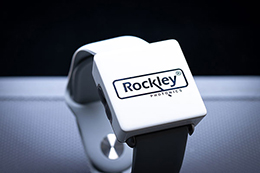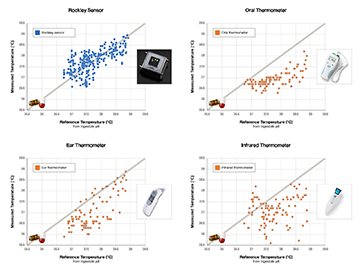
[Image: Rockley Photonics]
Researchers at Rockley Photonics, a US-based company developing “photonics-based health monitoring and communications solutions,” announced that they had completed preliminary human studies of the company’s wearable body temperature sensor. According to Rockley, its photonic sensor in the trial produced temperature measurements based on subdermal water absorption spectra that were more accurate than oral, ear and infrared thermometer readings.
“The initial results from these human studies are very encouraging, and they clearly show how effective our wearable sensing platform can be for determining core body temperature,” Andrew Rickman, chief executive officer and founder of Rockley, said in a company press release.
The body temperature sensor is the first of many the company hopes to add to a digital biomarker sensing platform that will help people make more informed decisions about their health.
Using water to measure body temperature
Core body temperature can provide information about a person’s health and potentially enable early detection of disease. Temperature measurements from oral, ear and infrared thermometers may not accurately reflect core temperatures because they take readings close to the body’s surface. Rockley’s new sensor was designed to measure temperature below the skin’s surface, providing, in principle, readings that are more consistent with true core temperature.
In a preliminary human trial, compared with auxiliary sensors, the temperature measurements made by Rockley’s sensors were more tightly grouped along the line of temperature readings produced by the reference sensor (an ingestible pill). [Image: Rockley Photonics] [Enlarge image]
The Rockley sensor is a spectrophotometer consisting of a laser emitter and detector. To calculate body temperature, the emitter generates lasers at different wavelengths that penetrate the skin at varying depths. Next, the detector measures the resulting water absorption signatures, which are a function of temperature.
To test the Rockley sensor’s accuracy, the company compared the spectrophotometer’s temperature readings with other common auxiliary methods (oral, ear and infrared thermometers), using an ingestible temperature sensor as reference for the actual body core temperature.
The data presented by the company indicated that the Rockley sensor temperature readings more closely matched the reference sensor than the auxiliary thermometers.
Future plans
The company will continue testing the body temperature sensor and hopes to expand its wearable biomarker sensing platform to include sensors to measure blood pressure as well as hydration, alcohol, lactate and glucose levels.

